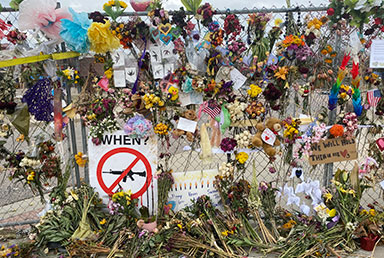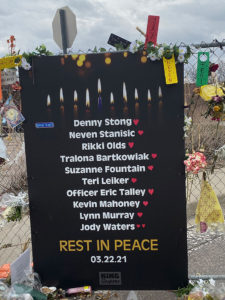
Once again a mass shooting has happened in the United States. Only this time it happened 20 minutes from my house. I read about the Atlanta shootings just days before, somewhat emotionally detached, if I’m honest. I’m not proud to write that. I had that luxury not knowing anyone directly impacted. Boulder, on the other hand, is a part of my community. I went to college and graduate school in Boulder. I have friends and colleagues in Boulder, and I sometimes shop at that grocery store. Since I’ve started writing this article there have been shootings in California, Maryland, Texas, South Carolina, and, a shooter was stopped at a high school in Tennessee.
Why Does This Keep Happening?
This is the question we all want answered, because then we have some power to stop it. This is the mission of the Violence Project; to look at multiple data points around mass shooters such as: mental health history, trauma, academics, community involvement, religion, violent video game usage, previous violent acts, employment status, and association with hate groups (to name a few), to try and understand how a person gets to the point of wanting to do this. Some common factors that have been identified are shooters are usually male, have a grievance, (defined by James Silver, criminal justice professor at Worcester University as “a wound that won’t heal, a sense of being wronged in the world”) and, the shooter will often post online or tell someone what he intends to do before he does it. This may be our most promising hope to stopping this kind of violence, and, it means we all have to be paying attention and be willing to speak up.
How Do I Cope With This Reality?
1) Take time to feel the impact. Avoiding your feelings can lead to anxiety, depression, disconnection, and apathy. It’s normal to feel a range of emotions such as grief, anger, fear, and helplessness. Greet all your emotions as would a good friend. Give them your undivided and kind attention. Don’t rush them out the door.
2) Address your trauma. Acts of violence can lead to feeling unsafe in the world, which can trigger other unresolved trauma. Don’t suffer alone. Talk to someone you trust. If needed, get professional support.
3) Look for beauty. Because our brains are hard wired to focus on the negative, referred to as the negativity bias, we have to make an extra effort to soak up the positive. Get outside. Read something uplifting. Look at art. Listen to music. Acknowledge the ways someone in your life supports you or loves you.
4) Find a creative outlet. Creativity can be a strong healing force. Write, draw, paint, sing, build, act, play. Enjoy the process and don’t focus on the outcome.
5) Get involved. The best way to prevent violence is to nurture connected relationships where people feel heard, seen, and valued. Start by looking in your own community: where do you see a need that fits with your skill set or passion? Don’t underestimate the power of small acts of kindness. Believe you have something to offer and that you can make a difference.
6) Grieve with others. Participate in an organized community event to mourn with others, or create your own small group to share your experience.
7) Educate yourself. This YouTube video features a retired Navy SEAL explaining how to survive an active shooter. In summary, it really depends on the situation you find yourself in, but the general instruction is run, hide, or fight.
How Do I Talk To My Kids About It?
It’s heartbreaking that we have to have these conversations, and, avoiding them is generally counter-productive, especially if your child already knows about it. Many of us did not grow up with this reality—we didn’t practice active shooter drills at school, or worry that we’d be shot in a grocery store—so it can be difficult to know what to say. The harsh truth is our children are growing up with this reality, and we have to acknowledge that.
1) Give age appropriate information. Generally speaking, the younger the child the less information you need to share. Very young children who are not aware of the issue can be protected by limiting their access to the news and the various screens that are everywhere. Older children/teenagers may benefit from being informed about what to do if they should find themselves in an active shooter situation. If you decide this kind of information is appropriate for your child, there are several videos available on YouTube about how to survive an active shooter. Preview them before showing your child, or watch them yourself and give an age appropriate summary.
2) Talk to your child about active shooter drills they have at school. Ask questions such as, how did you feel during the drill? What did the teacher tell you to do? Did you know it was a drill? Consider getting involved in your school community to examine the effectiveness of these drills. Unfortunately, the current data provided by Everytown Research and Policy shows that their effectiveness is questionable and that they increase anxiety and depression among students.
3) Teach emotional intelligence. Emotional intelligence includes the ability to know, feel, and regulate your own emotions, as well as recognize emotions in others, and the ability to empathize.
4) Listen. Your child may express their fear or confusion. Validate their feelings. Admit you don’t have all the answers. Provide extra comfort and support as needed, and let them know you will do whatever is in your power to keep them safe.
5) It’s OK to keep it short. If your child is signaling to you that they’ve had enough, follow their lead. Let them know you are available to talk about it anytime they want to.
Creating conscious communities begins with ourselves.
We are all being called to do our healing work and to contribute in our own unique way. Here are some ways clients, friends, and family members have answered the question:
How do you promote peace in your community?
- I facilitate courses for adults and teams with The Conflict Center. Their motto is, “Conflict in Inevitable. Violence is Not.”
- I help families of those incarcerated keep in touch with their loved ones and prison administrators.
- Compassionate listening.
- I promote peace in my community by helping others!
- I make eye contact with all people on trails or walking or hiking – saying hello or acknowledging their existence.
- I recycle and teach my children to take care of the land, sea, and environment as we are all connected. I do this by demonstrating, teaching, podcasts, National Geographic, and by cleaning up our neighborhoods of trash and graffiti.
- I promote peace in my community by greeting my neighbors by name and engaging with them by talking and listening to them.
- I promote peace in my community through acts of kindness and service. A “thank you for what you do” and offerings of help whenever those opportunities may arise go a long way toward building my community.
- Smile at someone passing by, say hello.
- Offer to help someone in need of help (example: a woman’s grocery bag ripped and I got a new bag and helped her pick up her items).
- We teach our kids, and remind ourselves, that most unkind behavior means that person is struggling, not bad.
- I promote peace in my community in small ways; a smile, a wave of acknowledgement when driving, holding the door, letting the person in a hurry go around me, thanking people, tipping service workers, being kind.
- I am kind to people that annoy me.
- I think one of the best, and most accessible, ways of promoting peace, is to model it for our children and the community around us. To model and promote understanding that moves us away from our baser instincts toward more fulfilling human connection; to the extent we can do this, we have planted a seed that spreads out into the greater world.
- I promote peace by playing my flute and encouraging others to play in a group with me or to come and enjoy the beautiful music.
- We have been shoveling the walk for our older neighbors when it snows. Also, like many other folks we increased our donations to food banks and other human service organizations as well as political campaigns that support women’s rights, gun control, and policies that reduce environmental impacts contributing to climate change.
- Treat others with kindness and give them the benefit of the doubt; you never know what someone is going through.
- If people (including myself!) make mistakes, it’s a learning moment. I don’t make people feel stupid for messing up, but try to be compassionate and patient.
- I try to be aware of people who have inappropriate or excessive anger and try to help them resolve their anger.
- By recognizing and getting help for people who struggle with life through teachers, therapists, doctors, priests, counselors, etc.
- I teach Non-Violent Communication.
![]()
![]()
![]()


